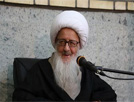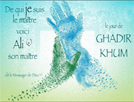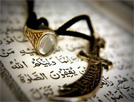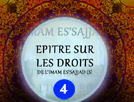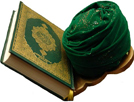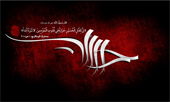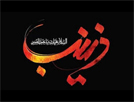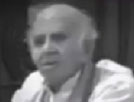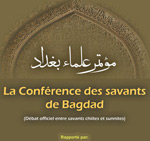NOTES
- Détails
- Catégorie parente: Bibliothèque-Islam
- Affichages : 1687
NOTES
1. "Uçûl al-Kâfî", d'al-Kulayni, chap.I, Hadith No 29.
2. "Plaisirs de la Philosophie", Will Durant.
3. Behâr al-Anwâr, vol. VI, p. 249.
4. Behâr al-Anwâr, vol. VI, p. 1450.
5. "Çahih Muslim", vol. II, p. 362, éd. de 'Issâ al-Halabi; "Çahih al-Tirmithi", vol. V, p. 328, éd., de Dâr al-Fikr, Beyrouth; "Mustadrak al-Hâkim, vol. III, p. 148, éd. de Haydarâbâd.
6. voir Mohammad Redhâ al-Mudhaffar, "Les Croyances du Chiisme", Éd. Abbas A. Al-Bostani, Montréal, 1997.
7. Voir: Al-Bayân Fî Tafsîr al-Qor'ân, p. 31.
8. "Al-Kâfî", chapitre: Fadhl-ul- Qor'ân.
9. "Wasâ'il al-Chi`ah'', vol. I, p. 370 .
10. Uçûl al-Kâfî.
11. ("Mir'ât al-Anwâr").
12. Dozy, Reinhart Pieter (Anne): (b. Feb. 21, 1820, Leiden, Neth.--d. April 29, 1883, Leiden), Dutch Arabist, best remembered for his monumental "Histoire des musulmans d'Espagne, jusqu'à la conquête de l'Andalousie par les Almoravides", 711-1110 (1861; Spanish Islam, 1913).
Dozy, of French Huguenot ancestry, spent 33 years (from 1850) as professor of history at the University of Leiden. Hishistory, a graphically written account of Moorish dominion in Spain that shed new light on many obscure points, long remained the standard work on the subject.
13. "al-Wasâ'ël".
14. Pour plus de détails, voir: "Wilâyat-ul-Faqih", de l'Imam Khomeini.
15. Voir Mohammad Bâqir al-Sadr: "A Short History of `Ilm al-Uçûl", Isp., 1983.
16. George SANTAYANA: Nom original: JORGE AUGUSTÍN NICOLÁS RUIZ DE SANTAYANA (né le16 décembre 1863, Madrid, Espagne- mort le26 Sept. 1952, Rome, Italie), philosophe, poète et humaniste hispano-américain qui fit une contribution importante à l'esthétique, à la philosophie spéculative et à la critique littéraire.(Pour plus de détails, voir: "Encyclopaedia Britannica"). N.D.T.
17. Carrel, Alexis: (b. June 28, 1873, Sainte-Foy-lès-Lyon, Fr.--d. Nov. 5, 1944, Paris), French surgeon, sociologist, and biologist who received the 1912 Nobel Prize for Physiology or Medicine for developing a method of suturing blood vessels and who laid the groundwork for further studies of transplantation of blood vessels and organs. He also investigated preservation of tissues outside the body and the application of the process to surgery. His strain of chick heart tissue was kept alive for more than 30 years.
Carrel received his M.D. (1900) from the University of Lyon. In 1904 he left France for theU.S., working first at the University of Chicago and then at the Rockefeller Institute for Medical Research in New York City. During World War I Carrel returned to France, where he helped to develop the Carrel-Dakin method of treating wounds with antiseptic irrigations. After 1919 he continued his work at the Rockefeller Institute until World War II. In 1941 he became director of the Fondation Française pour l'Étude des Problèmes Humains in Paris.
His writings include Man, the Unknown (1935); The Culture of Organs (with C.A. Lindbergh, 1938); and Reflections on Life (1952).
18. Voir: "Le Révélateur, le Messager, le Message", Ed. La Bibliothèque Ahl-Elbeit, Paris 1983.
19. Voir: "Aç-Çalât", Publications du Séminaire Islamique de Paris, 1985.
20. Voir à cet égard: "Le Jeûne de Ramadhân et ses Statuts", Abbas Ahmad al-Bostani, Ed. La Bibliothèque Ahl-Elbeit, Paris, 1985.
21. Voir: "Les Rites du Pèlerinage de la Mecque" (Manâsik al-Hajj), Ed. Abbas Ahmad al-Bostani, Montréal, Qc. 1997.
22. Voir: Ayatollâh Mohammad Bâqir al-Sadr: "Notre Économie", Dar Al-Thaqalayn, Beyrouth, 1995).
23. Voir: "Le Khoms et ses Statuts", Ed. Abbas Ahmad al-Bostani, Montréal, Qc, 1997.
24. Voir: "Philosophie de l'Islam", Ed. Abbas Ahmad al-Bostani- S.I.P.- Paris 1990.
25. Voir: Ibn Hichâm, "Sîrat al-Nabî", vol. II, pp. 147-148.
26. Ihrâm: Lorsqu'on accomplit le Pèlerinage de la Mecque (hajj), le port d'un vêtement spécifique (ihrâm) est requis.
27. Voir: "Al-Cawâ'iq al-Muhriqah" d'lbn Hajar al-Haythami al-Makki al-Châfi`î, p. 25. Ed. Matba`at al-Maymanah, Egypte; "Majma` al-Zawâ'id", d'al-Haythami al-Châfi`î p. 164, Ed. Maktabat al-Qudsi; "Tarikh Dimachq", d'Tbn 'Asâkir al-Châfi'î; AI-Ghadir", d'al-`Allâmah al-Aminî, vol. I, pp. 26-27, Ed. de Beyrouth; "'Abeqât al-Anwâr", de Hâmid Husayn, vol. XII, p. 312, Ed. d'Isphahân, etc.
28. Voir: "Çahih al-Tirmithî", vol. V, p. 328; éd. Dâr al-Fikr. Beyrouth: "Jâmi` al-Uçûl", d'lbn al-Athir, vol.I, p. 187, éd. d'Egypte; "Yanâbî` al-Mawaddah", d'al-Qandouri al-Hanafi, pp. 33, 40, 226, 355, éd. al-Haydariyyah; "Kanz al-'Ummâl", d'al-Muttaqi al-Hindi), vol III, p.154; Miftâh al-Najâ". d'al-Badakhchi, p9; "Musnad Ahmad Ibn Hanbal", vol. III, pp. 17, 26, éd. d'al-Maymaniyyah, Egypte; "Al-Mu'jam al-Çaghir", d'al-Tabarâni, vol. I, p. 131, éd. Dâr al-Naçr, Egypte; "Al-Mustadrak", d'al Hâkim, vol III, p. 109; "al-Fat-h al-Kabir", d'al-Nabahâni, vol. I, p. 252, éd. Dâr al-Ahyâ', Egypte; "Çahih Muslim, Kitâb al-Fadhâ 'il, chap. Fadhâ 'il Ali lbn Abi Tâlib. vol. II, p. 362, Éd. Isâ al-Halabi.
29. Voir: "Çahih Muslim", vol. VII, p. 130 "Çahîh al-Tirmithî", vol. XII, p. 85; "Musnad Ahmad Ibn Hanbal", vol. IV, p. 170; "Tafsir al-Tabari", vol. XX, p.5; "Tafsir Ibn Kathir", vol. III, p. 485; "Mustadrak al-Hâkim", vol. III, p.158.
30. Voir: "Çahih al-Bukhâri",p.175, egypte, 1335 hégire; "Çhih al-Tirmithi", vol.II, p.45, Delhi, 1342 hégire.
31. "Çahih Muslim",vol. II, p.191, Egypte 1348 hégire; "Sunan Abî Dâwoud", vol. II, p.207, Egypte; "Musnad Ahmad Ibn Hanbal", vol.V, p.106, Egypte, 1313 hégire; "Mustadrak al-Hâkim", vol.II, p.618, éd.al-Haydariyyah; "Taycîr al-Wuçûl `Alâ Jami` al-Uçûl ", vol, II, p.343, Egypte; "Târîkh Baghdâd", vol. XIV, p.353; "Yanâbî` al-Mawaddah", p.445 (Istanboul); Montakhab Kanz al-`Ummâl", vol.V, p.312.
32. Voir: "Çahîh al-Termithî", vol.V, p. 300, Éd. Dâr al-Fikr, Beyrouth; "Mustadrak al-Hâkim", vol. III p. 14; "Al-Fuçûl alMuhimmah", d'Ibn al-Çabbâgh al-Mâliki, p. 21, éd. al-Haydariyyah.
33. Voir: "Al-Termithî", dans son Çahih, vol. II, p. 299, rapporté d'Abdullâh Ibn 'Omar, par Muhib al-Dîn al-Tabari, vol. II, p. 167.
34. "Thakhâ'ir al-`Oqbâ'', de Muhib al-Dîn al-Tabari, p. 58, éd. du Caire, 1356 h.
35. "Târikh al-Bagdâdi", p. 321; Majma` al-Zawâ'id", d'AI-Haytharni al-Châfi`î, vol.VII, p. 35; Kanz al-`Ummâl, vol.VI, p.157.
36. ''Yanâbî` al-Mawaddah"; "al-Fuçûl al-Muhimmah"; "Musnad Ahmad Ibn Hanbal."
37. "Al-Mustadrak". d'al-Hâkim al-Nichâpourî; "Manâgib al-Khawârizmi al-Hanafi"; "Yanâbi` al-Mawaddah", d'al-Qandouzi al-Hanafi, etc.
38. Edward GIBBON: Historien anglais, né à Putney (Londres) «1737-1794», auteur d'une Histoire de la Décadence et de la Chute de l'Empire romain (1776-1788).
39. "Gibbon abridged by W. Smith", p. 466.
40. A`lâm al-Warâ",( Chap.Fadhâ'il al-Sibtayn),d'al-Tabari.
41. Voir: "Fadhâ'il al-Khamsah".
42. Voir: "Les Credos du Chiisme", Mohammad Redhâ al-Modhaffar, Ed. Abbas Ahmad al-Bostani, Paris 1990.
43. "Al-Çawâ`iq al-Muhriqah".
44. Voir: al-`Allâmah Kâchif al-Ghitâ', "Le Chiisme: Origines et Principes", Arcs, 1995.

